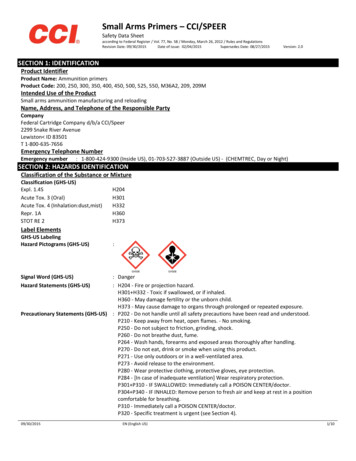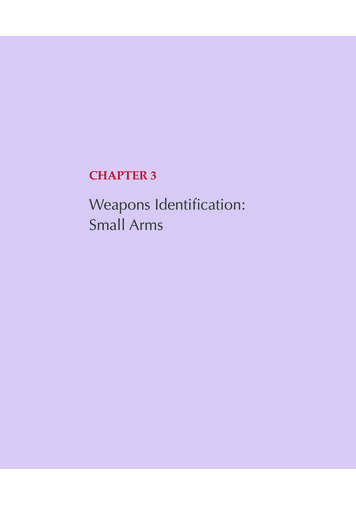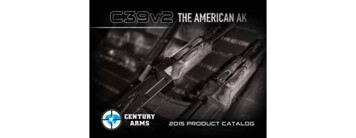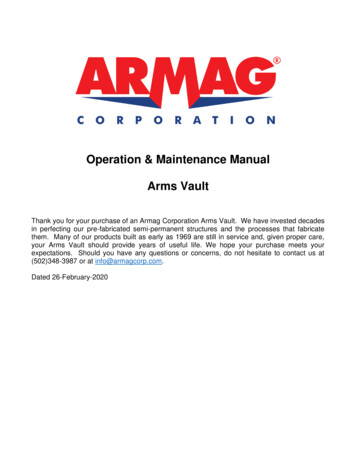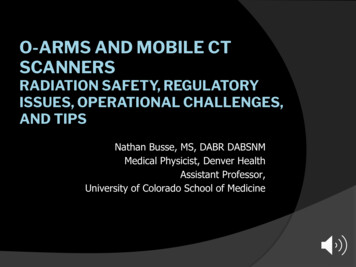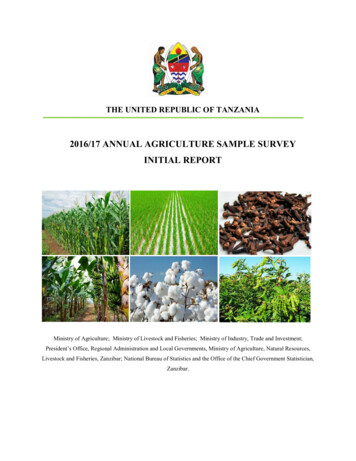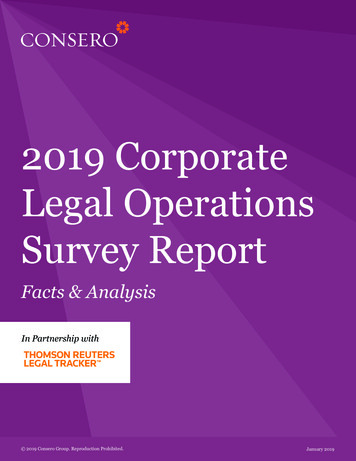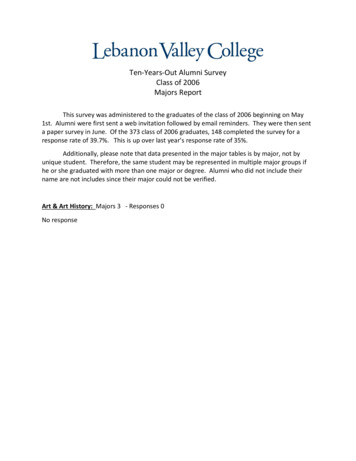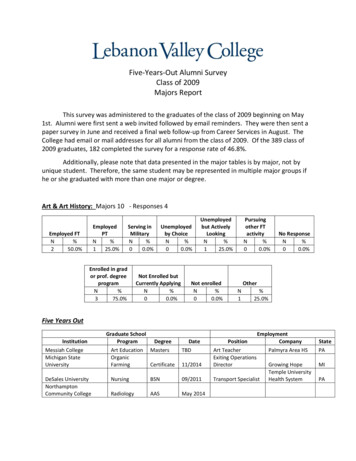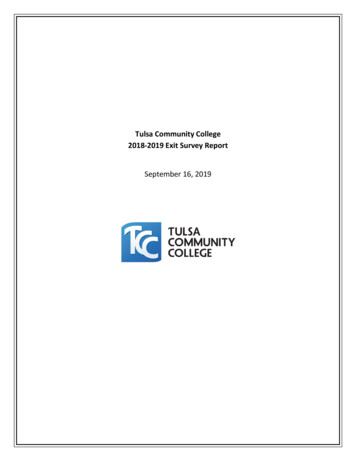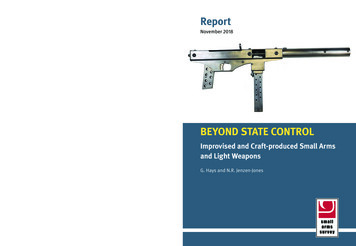
Transcription
ReportSmall Arms SurveyMaison de la PaixChemin Eugène-Rigot 2E1202 GenevaSwitzerlandt 41 22 908 5777f 41 22 732 2738einfo@smallarmssurvey.orgThe Small Arms Survey is a global centre of excellence whose mandate is to generate impartial, evidence-based, and policy-relevant knowledge on all aspects of small arms and armedviolence. It is the principal international source of expertise, information, and analysis onsmall arms and armed violence issues, and acts as a resource for governments, policymakers, researchers, and civil society. It is located in Geneva, Switzerland, at the GraduateInstitute of International and Development Studies.The Survey has an international staff with expertise in security studies, political science,law, economics, development studies, sociology, and criminology, and collaborates with anetwork of researchers, partner institutions, non-governmental organizations, and governments in more than 50 countries.For more information, please visit: www.smallarmssurvey.org.A publication of the Small Arms Survey with support from the Office of Weapons Removaland Abatement of the US Department of StateBeyond State ControlAbout theSmall Arms SurveyNovember 2018BEYOND STATE CONTROLImprovised and Craft-produced Small Armsand Light WeaponsG. Hays and N.R. Jenzen-Jones
BEYOND STATE CONTROLImprovised and Craft-produced Small Armsand Light WeaponsG. Hays and N.R. Jenzen-JonesA publication of the Small Arms Survey with support from the Office of WeaponsRemoval and Abatement of the US Department of State
CreditsPublished in Switzerland by the Small Arms Survey Small Arms Survey, Graduate Institute of International and Development Studies, Geneva, 2018First published in November 2018All rights reserved. No part of this publication may be reproduced, stored in a retrieval system,or transmitted, in any form or by any means, without prior permission in writing of the Small ArmsSurvey, or as expressly permitted by law, or under terms agreed with the appropriate reprographics rights organization. Enquiries concerning reproduction outside the scope of the above shouldbe sent to the publications coordinator, Small Arms Survey, at the address below.Small Arms SurveyGraduate Institute of International and Development StudiesMaison de la Paix, Chemin Eugène-Rigot 2E1202 Geneva, SwitzerlandThe Small Arms Survey takes no position regarding the status or name of countries or territoriesmentioned in this publication.Fact-checker: Natasia KalajdziovskiEditor: Tania InowlockiProofreader: Stephanie Huitson (readstephanie@ymail.com)Design and layout: Rick Jones (rick@studioexile.com)Printed by Gonnet in FranceISBN 978-2-940548-56-9Cover photo: A craft-produced sub-machine gun with an improvised suppressor design, producedby P.A. Luty in the United Kingdom. Source: N.R. Jenzen-Jones/ARES2Report November 2018
About the authorsN.R. Jenzen-Jones is a military arms and munitions specialist and intelligence analystfocusing on current and recent conflicts and emergent technologies. He is the directorof Armament Research Services (ARES). He has undertaken extensive research andanalysis on a range of small arms and light weapons and small- and medium-calibreammunition issues as well as on conventional arms proliferation; he has also producednumerous technical assessments of other weapon types, including incendiary weapons,cluster munitions, and indirect-fire artillery weapons. His other research fields includethe exploitation of technical intelligence to support counter-piracy, counter-narcotics,and the use of explosive weapons in populated areas. He is a certified armourer andammunition collector, and a member of international professional associations andsocieties such as the International Ammunition Association, the European CartridgeResearch Association, the International Ballistics Society, the Society for Libyan Studies,and the Ordnance Society.G. Hays is a firearms researcher with a specific interest in improvised and craft-producedweapons. He has documented hundreds of different designs and examined methodsof manufacture, design influences, and user types. He has produced original researchfor ARES and other organizations, mostly focusing on the design, development, andemployment of improvised and craft-produced small arms and light weapons.Hays and Jenzen-Jones Beyond State Control3
AcknowledgementsThe authors would like to express their gratitude to the individuals and organizationsthat supported them in the production of this report. Of particular note are JonathanFerguson, Ian McCollum, Tom Noakes, and Yuri Lyamin of ARES; Benjamin King, GlennMcDonald, and Matt Schroeder at the Small Arms Survey; Martin Parker at the NationalBallistics Intelligence Service; Gary Fleetwood at the Australian Criminal IntelligenceCommission; Steven Pavlovich at the Western Australia Police Force; independent specialists Aaron Brudenell, David J. Van Pelt, and Adrian Wilkinson; and others who mustremain anonymous for reasons of privacy and security.The authors would also like to extend special thanks to the staff at the National Firearms Centre at the Royal Armouries in Leeds, United Kingdom, for providing first-handaccess to a number of improvised small arms designs and permission to photographseveral items of interest.Publication of this Report was made possible thanks to financial support from the Officeof Weapons Removal and Abatement of the US Department of State.4Report November 2018
ContentsList of boxes, figures, and tables . 8List of abbreviations and acronyms . 9Executive summary . 11Key findings . 12Introduction . 13I. Terminology and characteristics . 17II. Developmental history . 21Early history22Second World War22Mid-twentieth century23Recent and current use24III. Methods and scale of manufacturing . 27Unskilled production28Local artisan production28Semi-professional production30IV. Users and global proliferation . 35Why use improvised and craft-produced weapons?36Use due to a lack of available alternatives39Preference for craft-produced weapons40Hays and Jenzen-Jones Beyond State Control5
Limitations of improvised and craft-produced firearms41Types of users and producers42Tribal groups and families44Hobbyists and collectors45Subsistence poachers46Individual criminals and criminal organizations47Insurgent groups and militias51States54V. Small-calibre ammunition . 55Commercially-available ammunition56Improvised small-calibre ammunition56VI. Improvised and craft-produced small arms . 61Disguised and adapted firearms62Zip guns64Shotguns and smoothbore muzzle-loading guns65Slam-fire pipe shotguns66Traditional smoothbore hunting weapons67HandgunsSingle-shot pistols69Single-shot pistols with triggers70Revolvers and pepperbox-type pistols71Self-loading pistols73Sub-machine guns75Northern Ireland77Latin America79Australia80Canada80Chechnya81Israel and the Palestinian Territories82Rifles and light cannon66983Rifles83Anti-materiel rifles and light cannon86Report November 2018
VII. Improvised and craft-produced light weapons . 91Grenade launchers and rifle grenades92Improvised rifle-launched grenades92Craft-produced grenade launchers used by Chechen separatists94Improvised grenade launchers used by Syrian rebel forces95Craft-produced rifle grenades used by Islamic State forces96Improvised grenade launchers used by Republican dissidentsin Northern Ireland97Improvised grenade launchers in Latin America98100Recoilless gunsRPG-2 type recoilless guns100Other recoilless weapons101Mortars103Rocket launchers106VIII. Safety and normative considerations . 109Safety considerations110Regulatory requirements111Applicable norms111Regulation of arms manufacturing112Marking, record-keeping, and tracing113Regulation of international transfers114Regulation of design information114Forensic considerations and law enforcement challenges116Conclusion . 119Endnotes . 121References . 128Hays and Jenzen-Jones Beyond State Control7
List of boxes and tablesBoxes1Transfer of designs and know-how2Copies of industrially manufactured weapons313Transfers of craft-produced firearms across borders494FARC–Provisional IRA cooperation in Colombia535Improvised and craft-produced air-delivered weapons10863D-printed firearms11525Tables1Non-industrially produced firearms, by type of manufacture192Pricing of selected improvised and craft-produced weapons373Users and producers of improvised and craft-produced weapons,their motivations, and associated risks438Report November 2018
List of abbreviations and acronymsACPAutomatic Colt PistolAECAArms Export Control ActAMRAnti-materiel rifleARESArmament Research ServicesAUDAustralian dollarBRLBrazilian realCNCComputer numerical controlCNYChinese yuanEGPEgyptian poundFARCFuerzas Armadas Revolucionarias de ColombiaFATAFederally Administered Tribal AreasIEDImprovised explosive deviceILSIsraeli new shekelINRIndian rupeeIPGImprovised Projected GrenadeIRAIrish Republican ArmyITARInternational Traffic in Arms RegulationsITIInternational Instrument to Enable States to Identify and Trace, in aTimely and Reliable Manner, Illicit Small Arms and Light WeaponsLRLong rifleLYDLibyan dinarMANPADSMan-portable air defence systemPoAProgramme of Action to Prevent, Combat and Eradicate the Illicit Tradein Small Arms and Light Weapons in All Its AspectsHays and Jenzen-Jones Beyond State Control9
PRIGProjected Recoilless Improvised GrenadeRPGRuchnoy protivotankovyy granatomyot(handheld anti-tank grenade launcher)RUCRoyal Ulster ConstabularyTHBThai bahtUAVUnmanned aerial vehicleUSDUnited States dollarYPGYekîneyên Parastina Gel (People’s Protection Units)10Report November 2018
Executive summaryImprovised and craft-produced small arms and light weapons are widespread in manyparts of the world, even if they account for a small fraction of global holdings. Moredata is needed before researchers can arrive at a reliable estimate of these holdings,yet the figure is doubtless in the millions.These weapons have been manufactured for as long as firearms have existed, typicallyby hand or in small workshops. Many are based on principles that are simple to replicate, such that individuals need only conduct minimal research to produce the mostbasic examples. However, advancements in materials science, production technologies,and globalized communications have meant that more effective and efficient designsare now available to criminals, armed groups, and pseudo-states. While craft producersare not manufacturing advanced man-portable air defence systems (MANPADS) or antitank guided weapons (ATGWs), they are constructing other types of light weapons—including mortars, recoilless guns, and grenade launchers—with some regularity.This report presents the results of a long-term assessment of the broad and looselydefined field of improvised and craft-produced small arms and light weapons. In evaluating the nature and scale of production, acquisition patterns, and implications forlaw enforcement and policy, it identifies producers, users, and their motivations, alongwith emerging trends that may require monitoring and action. The study presents dataand evaluations based on original and desk-based research, including interviews andhands-on technical appraisals of dozens of improvised and craft-produced weapons.Improvised and craft-produced small arms and light weapons—which vary widely interms of quality and safety—remain an important source of firepower for a wide rangeof actors, including tribal groups, poachers, criminals, insurgent groups, and even somestates and quasi-state groups. In some areas, these weapons account for the vastmajority of firearms used in crime; in others, their production is institutionalized, providing essential income for local gunsmiths. Some of these weapons are used locally,others are trafficked on a national, regional, or international scale. In Iraq, Libya, Syria,Ukraine, and elsewhere, armed non-state actors are regularly developing and employing new designs of improvised and craft-produced small arms and light weapons.In the future, it may be possible to bypass traditional manufacturing and instead to produce entire firearms by using n
Survey, or as expressly permitted by law, or under terms agreed with the appropriate reprograph-ics rights organization. Enquiries concerning reproduction outside the scope of the above should be sent to the publications coordinator, Small Arms Survey, at the address below. Small Arms Survey Graduate Institute of International and Development Studies Maison de la Paix, Chemin Eugène-Rigot 2E .
